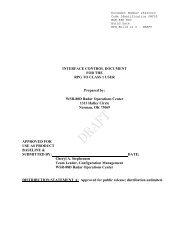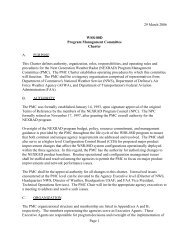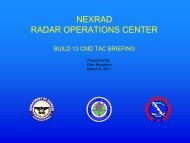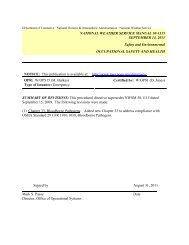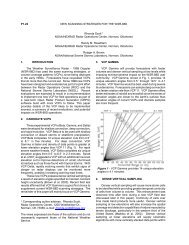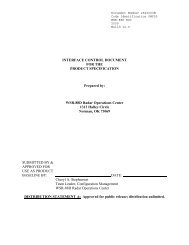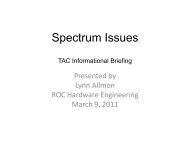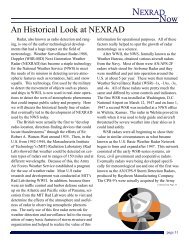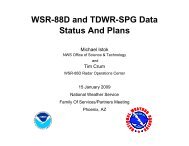Issue 13 - NEXRAD Radar Operations Center - NOAA
Issue 13 - NEXRAD Radar Operations Center - NOAA
Issue 13 - NEXRAD Radar Operations Center - NOAA
You also want an ePaper? Increase the reach of your titles
YUMPU automatically turns print PDFs into web optimized ePapers that Google loves.
<strong>NEXRAD</strong>NowBuild 5.0 Precipitation Processing Subsystem ChangesAmong the most important changes introduced with<strong>Radar</strong> Products Generator (RPG) Build 5.0 software wasthe implementation of new Volume Coverage Patterns(VCPs), namely VCP 12 and VCP 121. VCP 121 hasthe same elevation angles as the legacy (original) VCP21. However, VCP 12 contains some elevation anglesnever used in WSR-88D legacy VCPs. Therefore, somechanges were made in the Precipitation Processing Subsystem(PPS): 1) the construction of the hybrid scanusing blockage files that enabled both new and prior elevationangles, 2) moving thresholds for initiation andend of accumulations from the Precipitation DetectionFunction (PDF) to a new version of the Hydromet Preprocessingalgorithm, 3) the reduction of clutter contaminationby the use of the <strong>Radar</strong> Echo Classifier (REC)instead of the legacy tilt test, and 4) the use of exclusionzones to ensure that ground returns, especially thoseclose to the radar, are not used in accumulations.The hybrid scan is a combination of reflectivity fromelevation angles and ranges that determine the reflectivitymost representative of precipitation reaching theground. Prior to Build 5.0 the PPS used static terrainbasedoccultation (or blockage) data and hybrid scansector definition files to build a hybrid scan reflectivity(HSR), which is the basis for precipitation computationsin the PPS. The static files could be used, because theelevation angles at or below 3.5° were approximately thesame for all legacy VCPs. Rather than create an additionalhybrid scan definition for each new VCP, the<strong>Radar</strong> Operation <strong>Center</strong> (ROC) and the NationalWeather Service (NWS) Office of Hydrologic Development(OHD) created a replacement for the original (legacy)Hydromet Preprocessing algorithm, calledEnhanced Preprocessing (EPRE), that allows precipitationestimates to be computed from a VCP with any elevationangles. The new PPS uses high resolution BeamBlockage Algorithm data files to aid in the constructionof the HSR.An additional change starting with Build 5.0 is theincorporation of initiation and end of precipitation accumulationsin the EPRE algorithm. This was previouslyperformed by the PDF, which included a parameter forthe detected area above a specified reflectivity level thatmust be exceeded before starting accumulation: theNominal Clutter Area (i.e., an area that is called clutter).This clutter area was a residual after clutter filtering(application of clutter suppression regions). Note thatclutter suppression affects base data, such as BaseReflectivity, and all products derived from them. TheNominal Clutter Area only affected precipitation accumulations.The equivalent parameter in the EPRE algorithmis RAINA. The threshold of reflectivity for theprecipitation area computation is the parameter, RAINZ,in decibels of reflectivity, dBZ. This was previously indecibels of rainfall rate, dBR, and identified as “PrecipRate Thrsh” in the PDF. The PDF remains in RPG softwareas the function that automatically causes the systemto change from Clear Air Mode to PrecipitationMode (VCP 21).The legacy PPS used the following tilt test to determinewhether the lowest angle had clutter contamination- if the reduction of coverage of significant echoesfrom the 0.5° elevation to the 1.5° elevation was greaterthan 75%, the lowest elevation angle was assumed to becontaminated and was discarded from the Hybrid Scan;the 1.5° angle was used instead. EPRE can eliminateclutter contamination from precipitation accumulationby using the REC. REC products, Clutter LikelihoodReflectivity (CLR) and Clutter Likelihood Doppler(CLD), are viewable as backgrounds on the RPGHuman Computer Interface (HCI) Clutter Regionsgraphical user interface. EPRE uses a percentage probabilityfrom the REC above which the radar returns areconsidered to be from clutter and are, therefore,excluded from accumulations. Because the new methoduses the lowest elevation angle whenever possible, theresulting accumulations may be higher than computedby the legacy PPS.Because Build 5.0 testing revealed there was stillsome residual ground clutter close to each radar site, itwas decided that the 500-foot rule would be applied inthe form of hard-coded exclusion zones. This excludesdata from being used in precipitation estimation for allelevations at or below 1.6° from a range of 0 to 5 nauticalmiles (nm), for all elevations at or below 1.0° from arange of 5 to 9 nm, and for all elevations at or below0.6° from a range of 9 to 25 nm from the radar. (SeeFigure 1 below for an illustration of these generic exclusionzones.) The result will sometimes be discernible“rings” in precipitation accumulations when there ispredominantly low stratiform precipitation, but will be(Continued on Page 12)page 11



